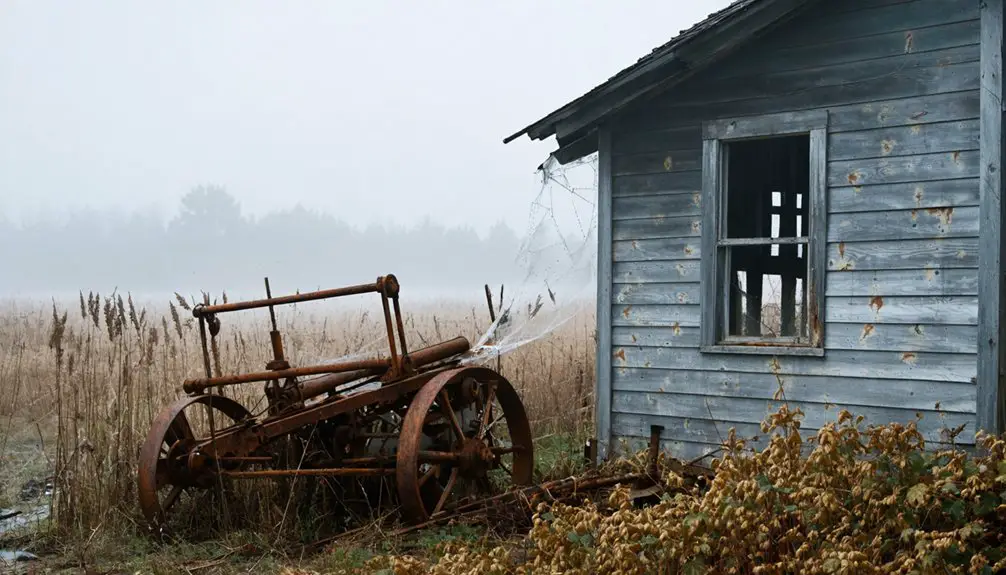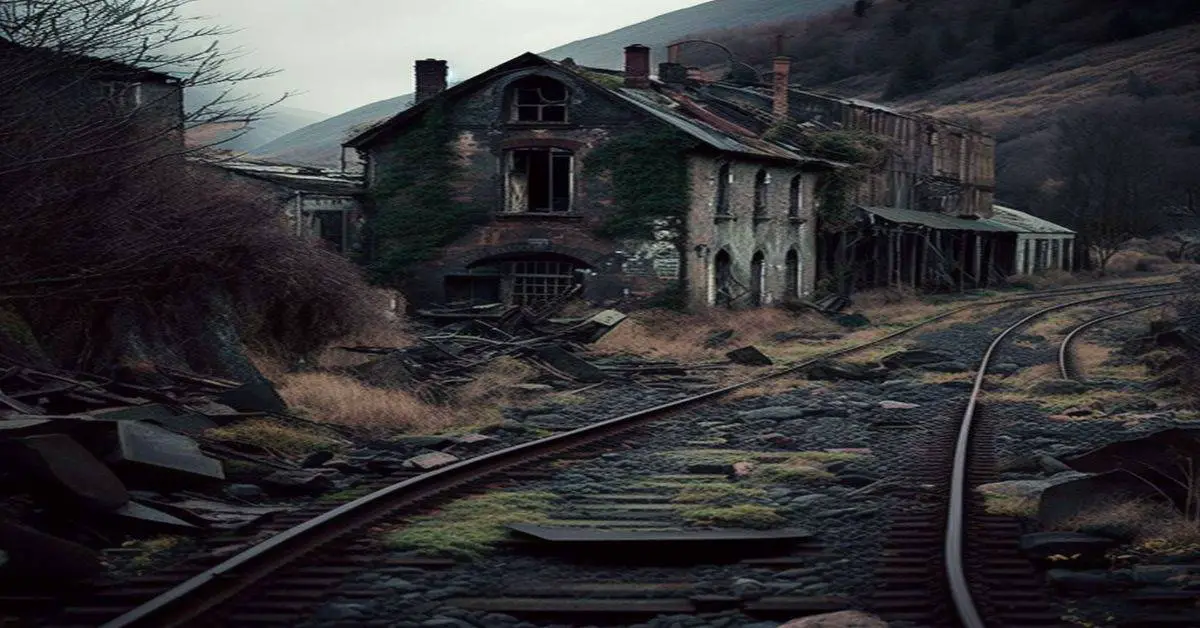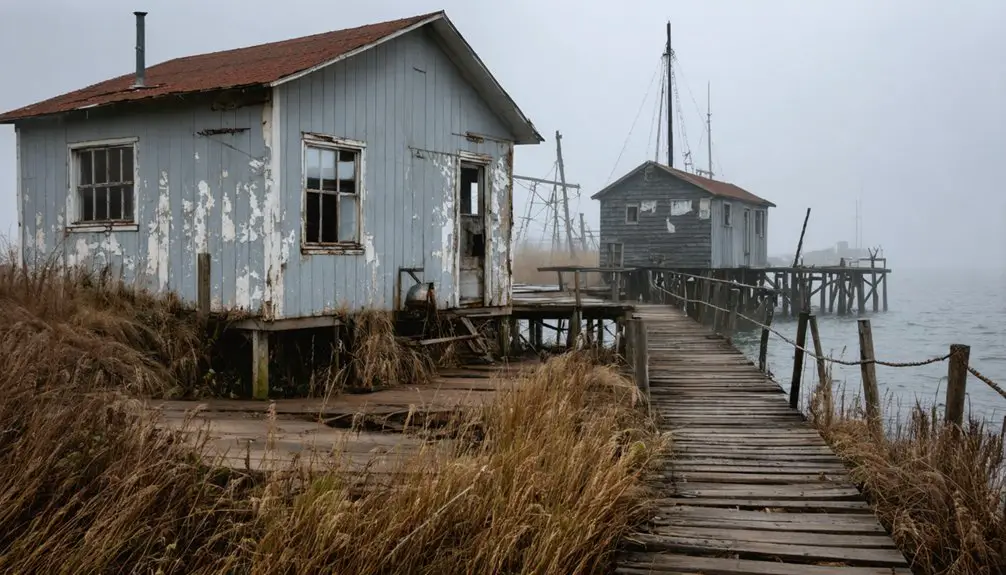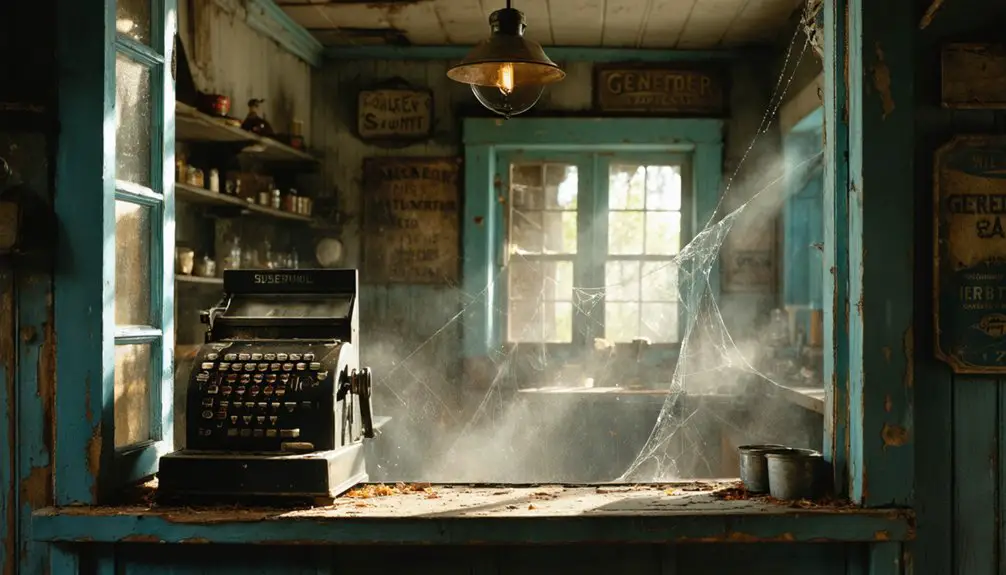You’ll find Little Wolf’s ghost town remnants along Wisconsin’s Wolf River, where William Goldberg first settled in 1848. The town flourished as a lumber hub through the 1880s, with sawmills processing hardwood and softwood for Chicago and Milwaukee markets. Once-bustling streets now showcase weathered foundations, neglected cemeteries, and the historic Poor Farm from 1876. The scattered traces of this former community tell fascinating tales of pioneer life’s rise and fall.
Key Takeaways
- Little Wolf, Wisconsin began as a pioneer settlement in 1848 with William Goldberg as its first settler, thriving initially through agriculture and logging.
- The town’s economy peaked in the 1880s through lumber production, supported by sawmills and railroad transportation to major markets.
- Lack of rail connections and highways eventually isolated the community, causing younger residents to migrate to urban areas.
- The township’s decline is marked by abandoned schoolhouses, churches, and the historic Poor Farm established in 1876.
- Physical remains include weathered building foundations, neglected cemeteries, and the Zeeland Mill’s stone foundation from the mid-19th century.
Early Pioneer Settlement and Founding Years
As pioneers pushed westward into Wisconsin Territory during the late 1840s, William Goldberg established himself as Little Wolf’s first permanent settler in 1848, soon followed by George E. and J.P. More. Their pioneer motivations aligned with the broader migration from eastern states like New York and Ohio, as settlers sought new opportunities in the untamed wilderness.
James and Peter Meiklejohn joined the settlement in 1850, facing settlement challenges typical of frontier life. The area, previously home to the Menominee people, underwent rapid transformation as newcomers established farms and timber operations. The abundance of pine and oak forests provided essential building materials and economic opportunities. Much like the Ghost River trail markers that would guide travelers a century later in Tennessee, the early settlers relied on blazed trees to navigate through the dense Wisconsin forests.
Peter Meiklejohn’s leadership as the town’s first chairman helped forge early governance structures, while the establishment of bounties for wolf scalps reflected the practical concerns of frontier survival. The arrival of Methodist circuit rider Silas Miller in 1850 brought spiritual comfort to these determined pioneers.
Daily Life in 19th Century Little Wolf
While pioneer settlers faced grueling physical demands in Little Wolf, their daily routines centered around essential agricultural and logging activities.
You’d find families tending to crops like corn and beans, while preserving food for winter months in their gardens. Agricultural practices merged with logging activities, as teamsters guided horses and oxen to haul timber from nearby camps. The county later established a poor farm residency to support struggling community members.
After daylight hours, you’d witness workers maintaining tools and mending clothes. The loggers relied heavily on frozen ground conditions during Wisconsin winters for their operations.
Communal meals brought people together, often enjoyed outdoors during work breaks. Seasonal labor dominated life, but evenings fostered rich social interactions. You might hear folk songs like “Little Brown Bulls” echoing from bunkhouses, or join storytelling sessions that strengthened community bonds.
Despite harsh conditions, cultural traditions and shared work created a resilient community spirit.
Notable Families and Community Leaders
From the moment William Goldberg staked his claim in 1848, Little Wolf’s founding families shaped the town’s destiny through their pioneering spirit and leadership.
George and J.P. More soon joined him, establishing the core of early settlement. Family alliances strengthened the community when Edson Casey married into the prominent Bishop clan, known for their agricultural excellence under Ira J. Bishop’s guidance. They transformed wild government land into prosperous farms that sustained the growing population.
The leadership dynamics of Little Wolf centered on these founding families who controlled land distribution and governance. Like many communities in Wisconsin, they maintained detailed manila folders labeled “Werewolf” documenting strange occurrences in the area.
The Barnard and Tyler families merged their interests through marriage, creating powerful business ventures. You’ll find their influence extended beyond commerce – they organized religious gatherings, local fairs, and built the town’s infrastructure.
Even after Little Wolf’s decline, these families’ descendants continued to shape Waupaca County’s development.
Economic Activities and Local Industries
The lumber industry emerged as Little Wolf’s economic cornerstone during the 1880s, when expanding railroad networks transformed Wisconsin’s northern frontier into a timber production powerhouse. You would’ve found bustling sawmills processing both hardwood and softwood, while nearby manufacturing operations crafted furniture, barrels, and specialized wood products. The growing demand for wood from Chicago and Milwaukee spurred the town’s rapid development into a lumber center.
Beyond lumber production, Little Wolf’s economy diversified through agricultural processing and support industries. You’d have encountered flour mills, wagon shops, and tanneries serving local farmers, creating a resilient mixed economy. Similar to the historic Holt & Balcom Logging Camp, the town maintained several logging camps that supported its thriving timber operations.
The railroad’s presence strengthened this economic web, enabling efficient transport of goods to distant markets. The town’s commercial district featured mercantile shops, hotels, and various services catering to workers, while small-scale manufacturers like foundries and breweries rounded out the local industrial landscape.
The Gradual Decline of a Rural Township
As pioneer families established Little Wolf’s first homesteads in 1850, they couldn’t have foreseen the gradual unraveling of their rural community over the next century.
Despite early signs of rural nostalgia, the once-thriving township faced mounting challenges that tested its community resilience.
You’ll find the story of Little Wolf’s decline written in its empty schoolhouses and shuttered Lutheran church, which once anchored social life since 1867.
One notable remnant of the area’s past is the historic Poor Farm, established in 1876 as a public assistance facility for those unable to support themselves.
Initial settlers relied heavily on venison and game for survival due to limited access to provisions and supplies.
The absence of rail lines and major highways isolated the community, while younger generations sought opportunities in urban centers.
The township’s agricultural foundation weakened as market pressures forced family farms to consolidate or close.
Environmental concerns, from soil depletion to watershed issues, further complicated farming efforts.
The landscape gradually returned to wilderness, marking the final chapter of Little Wolf’s transformation from settlement to ghost town.
Remaining Traces and Historical Sites
If you visit Little Wolf today, you’ll find scattered physical traces of the former township through stone foundations, cellar holes, and weathered building materials partially reclaimed by forest growth.
Pioneer-era family cemeteries, featuring 19th-century headstones of founding families, represent some of the few maintained historical sites in the area.
While the ghost town lacks official state historical markers, nearby archaeological sites like Murphy Resort ruins and the Thomaston Fishing Settlement provide valuable context for understanding Little Wolf’s place in Oconto County’s past.
Physical Remnants Today
Modern visitors to Little Wolf’s former townsite will find only scattered traces of its once-thriving community, with most physical remnants reduced to weathered building foundations hidden beneath encroaching vegetation.
You’ll discover small, often neglected cemeteries that serve as silent witnesses to the town’s past inhabitants, with weathered grave markers providing valuable historical data through their epitaphs and dates.
Archaeological findings around the site include surface scatters of domestic items like ceramics and glass, while old roadways can still be traced through satellite imagery or ground surveys.
The landscape has largely reverted to forest and pasture, though natural features like rivers remain unchanged.
While few official historical markers exist at Little Wolf compared to other Wisconsin ghost towns, the site’s artifacts continue contributing to our understanding of its cultural heritage.
Pioneer Building Foundations
Pioneer foundations scattered across Little Wolf’s landscape tell a compelling story of mid-19th century settlement ingenuity.
You’ll find early settlement architecture dominated by stone and timber foundations, with pioneers using materials harvested directly from the surrounding wilderness. The most impressive pioneer construction techniques are visible in the remains of the Zeeland Mill‘s 36 x 50 foot stone foundation and St. John’s church foundation from 1863.
These structures relied on river-sourced stones and community-driven labor. Near the Little Wolf River, you’ll discover foundations built on raised gravel beds to combat flooding, while mill foundations feature thick stone bases engineered to support heavy equipment.
The scattered stone remnants you see today mark the determined spirit of Little Wolf’s earliest builders.
Historical Site Documentation
Beyond the scattered stone foundations, Little Wolf’s historical sites paint a broader picture of nineteenth-century life through its cemeteries, commercial ruins, and transportation remnants.
You’ll find pioneer family names like Frost, Smart, and Crowell etched on weathered headstones in the area’s oldest cemetery, which predates 1900. The site preservation efforts have maintained vital evidence of early settlement patterns and cultural practices.
Historical documentation reveals the town’s evolution through remnants of log cabins, resort buildings, and commercial structures like the ill-fated Swamp Hotel that burned in 1932.
You can trace old stagecoach routes and discover abandoned segments of the Fort Howard to Menominee Road, while ruined bridge foundations near waterways testify to the region’s logging heritage.
Preservation Efforts and Local Archives
Throughout the 1990s, the Wolf River Conservancy spearheaded essential preservation initiatives near Little Wolf, beginning with the strategic purchase of a 50-acre “lunch spot” parcel along the Wolf River. Their efforts expanded to include acquiring adjacent plantations, preventing logging and habitat fragmentation, while partnering with Tennessee to establish the Ghost River State Natural Area.
The Town Board actively manages these preservation efforts through community engagement and formal resolutions, working alongside neighboring municipalities to protect property values and natural resources.
You’ll find thorough documentation in local archives, which offer archive accessibility through partnerships between the Wisconsin Historical Society and local historical organizations. These collections house critical records, photographs, and artifacts that tell the story of Little Wolf’s transformation, economic shifts, and ongoing conservation efforts.
Regional Impact and Historical Significance
Little Wolf’s 1848 founding by William Goldsburg created a settlement pattern that you’ll recognize throughout early Wisconsin, where pioneers established townships near essential resources and transportation routes.
You’ll find that Little Wolf’s influence extended beyond its borders through its dual representation on rival county boards in the 1850s, reflecting the complex political dynamics of early Waupaca County development.
The town’s eventual decline mirrors the broader economic shifts you’ve seen across Wisconsin’s ghost towns, particularly as the lumber industry waned and populations migrated to more prosperous areas.
Pioneer Settlement Patterns
When William Goldsburg established the first pioneer settlement in 1848, he initiated a wave of migration that would transform the Little Wolf region into an essential crossroads between the Wolf and Wisconsin Rivers.
You’ll find that pioneer migration quickly followed, with George and J.P. Moore arriving in 1849, drawn to the area’s strategic location and natural resources. The Old Wolf River Crossing, previously an indigenous village site, became the gateway for settlers after 1852 when lands opened legislatively.
Settlement challenges didn’t deter these early pioneers who built the foundations of their community at what was first called Centerville. They established sawmills, opened stores, and created significant institutions like the first schoolhouse in 1857, while maintaining complex relationships with the Winnebago and Menominee tribes who’d long inhabited the region.
Economic Decline Effects
Despite initial prosperity from timber extraction, the economic foundation of Little Wolf began crumbling in the late 19th century as the region’s vast forests succumbed to intensive logging operations.
You’ll find that without economic resilience strategies, the town’s fate was sealed by its dependence on a single industry. Once-bustling sawmills fell silent as timber resources vanished, triggering a cascade of business closures and population exodus.
Community rebuilding initiatives proved futile against the overwhelming tide of industrial decline.
- Railroad abandonment isolated the town from essential market connections
- Job losses forced working-age residents to migrate to urban centers
- Local services and infrastructure deteriorated as tax bases shrank
- Social institutions like schools and churches closed, devastating community bonds
Tales and Legends From Little Wolf
Among Wisconsin’s most enduring folklore, tales of a mysterious wolf-like creature have haunted the Little Wolf and Waupaca areas since the 1930s. The earliest wolf sightings occurred when a night watchman spotted the beast digging at an Indian burial mound near St. Coletta School in Jefferson County.
Ancient Wisconsin lore tells of a fearsome wolf-beast stalking Little Wolf and Waupaca, first seen desecrating burial grounds in Jefferson County.
You’ll find creature lore describing a massive, upright-walking beast with glowing red eyes that’s known to chase people and attack vehicles.
It’s been spotted kneeling like a human while feeding on roadkill and hunting deer across Walworth County, particularly along Bray Road near Elkhorn and Lake Geneva.
While many locals faced ridicule for reporting encounters, the legend gained national attention after a 1991 newspaper article and a 1993 Inside Edition segment, spawning tourism and merchandise in this haunted region.
Frequently Asked Questions
Are There Any Paranormal Investigations or Ghost Sightings in Little Wolf?
You won’t find any official ghost tours or documented supernatural experiences here, as historical records and paranormal investigators haven’t reported any verified ghostly activity in this former settlement’s history.
What Caused the Final Resident to Leave Little Wolf?
You’ll find the final exodus reasons centered on isolation and service loss – the last resident likely left due to limited access to necessities, infrastructure decay, and lack of community support.
Can Visitors Legally Explore the Abandoned Areas of Little Wolf?
Want to explore abandoned places legally? You can’t freely access Little Wolf’s abandoned areas without permission, as legal restrictions require you to obtain consent from private property owners or town authorities first.
Did Native American Tribes Inhabit the Area Before Little Wolf’s Settlement?
You’ll find rich tribal history in this region, where Menominee Indians lived between the Wolf and Fox Rivers, demonstrating cultural significance through fishing, hunting, and wild rice gathering before European settlement began.
How Does Little Wolf’s Winter Weather Affect Access to Historical Sites?
You’ll face significant winter access challenges with heavy snowfall reaching 10.9 inches in December. Icy conditions and unplowed rural roads often require 4WD vehicles and proper winter gear for safe exploration.
References
- https://en.wikipedia.org/wiki/Beast_of_Bray_Road
- https://www.americanghostwalks.com/articles/lake-geneva-ghosts-the-beast-of-bray-road
- https://www.youtube.com/watch?v=Lr3PYbaeL0k
- https://wagswi.org/libraryRecords.php?le=f1_c52
- https://justapedia.org/wiki/Little_Wolf
- http://www.town-littlewolf.com
- https://kids.kiddle.co/Waupaca_County
- https://www.formycousins.com/1878/1878atlas-Waupaca.html
- https://www.wolfriver.org/news-press/how-the-ghost-river-got-its-name-a-40th-anniversary-reflection
- https://www.waupacahistoricalsociety.org/The Early Foundation and Development of Waupaca County- Wisconsin Booklet HC-L-21-32-1.pdf



